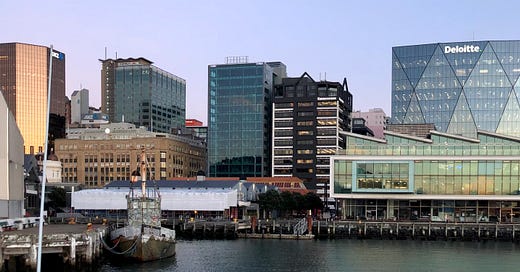A recent drowning on the Wellington waterfront, and calls from a Wellington City Councillor (Nureddin Abdurahman) for fencing along parts of the waterfront to prevent such deaths, was the subject of an article by Tom Hunt in a recent edition of the Dominion Post.
No plans to put up barriers
Approximately 1 km of the Wellington waterfront has a vertical drop of at least two metres to the water, and it is in these sections that the danger lies.
There have been nine waterfront deaths by drowning since 2006, an average of 0.5 per year, according to the article. Speaking of a 2016 death, Council spokesman Richard MacLean stated there were "no plans to put barriers at the water's edge", and that "the public would be up in arms if we started putting up barriers everywhere".
Erecting barriers seems to be similar in principle to road safety improvements. In respect of improvements that save lives, the Ministry of Transport's main decision criterion is whether the cost of improvements would be less than the value of lives saved, with each life valued at $12.5m.1
Fences are cheap
A quick Google search of fencing costs revealed figures in the hundreds of dollars per metre. So the cost would be no more than $1000 per metre, or no more than $1m for 1 km. The economic life of this fence would presumably be at least 40 years, and allowing for maintenance over the period, the total cost would presumably not exceed $1.5m. It would save 20 lives, using the historical rate of 0.5 per year. At $12.5m each, the value of these lives would be $250m, which is 167 times the cost. It would therefore seem to be a no brainer to install the barriers — or would be a no brainer if the Ministry of Transport were responsible for it and applied their usual decision rule.
However, if Mr MacLean's comments in 2016 are indicative of Council thinking then and since, the Council's objections are purely aesthetic; that is, the barriers would spoil the view!
I cannot imagine that the Ministry of Transport would reject a proposal to erect a safety barrier at the side of the road purely on aesthetic grounds. Nor can I imagine the Council rejecting this proposal if the number of deaths were considerably larger. Accordingly, I suspect that the Council’s rationale for not erecting the barrier was financial rather than aesthetic. In effect, they would be valuing the 20 lives saved at less than the $1.5m cost of the barrier, and therefore valuing each life at less than $75,000. Thus, whilst the Ministry of Transport values a life at $12.5m, the Council seems to value them at less than $75,000.
Different lives, different values
This is part of a much wider problem in the public sector, in which different public sector entities value lives quite differently. A spectacular example is the earthquake strengthening regulations, which requires buildings below 34% of New Building Standard (NBS) to be upgraded to 34%. In a 2012 cost-benefit analysis produced for the Ministry of Business Innovation and Employment (MBIE) and concerned inter alia with this requirement, the costs of doing so were estimated at $958m whilst the benefits were estimated at only $25m.2
These benefits comprise lives saved, injuries avoided, and avoided damage to buildings,3 but are not separately identified. Using data from the Institute of Geological and Nuclear Sciences (GNS), Martin Jenkins estimated the expected deaths with no strengthening at 0.96 per year declining to 0.72 if strengthening to 34% NBS were undertaken.4 So, the expected saving in lives from the strengthening would be 0.24 per year. This applies to each year in the 75 year period used in the analysis,5 and therefore yields an expected saving of 75*0.24 = 18 lives over that period.
The Government’s decision to require the upgrading of buildings rated below 34% implies that it valued the benefits from doing so at $958m or higher. The benefits in the form of avoided damage to buildings are judged by Martin Jenkins to be small,6 and in any case could not exceed the total benefits of $25m. They can be deducted from the upgrading costs of $958m, to yield net upgrade costs of $933m to $958m. So, using the data from GNS (which is a government entity) to estimate the expected savings in lives from the strengthening decision, that decision implies a value per life saved of at least $933m/18 = $51.8m, which is at least $68m today.7
Interestingly, the major contributor to these potential earthquake deaths is Wellington,8 because it has the highest probability of experiencing a major earthquake amongst major urban areas in New Zealand. Thus, central government values earthquake deaths in New Zealand at $68m each, and is prepared to (direct others to) spend this to save an expected 0.24 lives per year, mostly in Wellington. By contrast, the Wellington City Council appears to value the lives of those drowning on the waterfront at only $75,000 each, and therefore is not constructing a barrier on the waterfront that could be expected to save twice as many lives per year as the earthquake upgrades, at a cost per life of one tenth of one percent of the earthquake regulations.
Aiming for consistency
Perhaps government needs to set up an entity like the Ministry of Transport, whose goal would be to identify death hotspots that are not covered by any other central government entity, assess whether remedial actions would cost less than $12.5m per death avoided, and then fund those projects. Government might also like to consider whether some interventions and regulations, such as the earthquake strengthening regulations, are worth the cost.
By Martin Lally, Capital Financial Consultants Ltd.
See page 54 of NZTA (2023) Monetised benefits and costs manual (April 2023, Version 1.6).
See page 41 of the 2012 report by Martin Jenkins: Indicative CBA Model for Earthquake prone building review - Summary of methodology and results.
Ibid, page 3.
Ibid, page 37.
Ibid, page 3.
Ibid, page 5.
Allowing for 32% cost inflation from 2012 to 2022, the figure would be at least $68m today (using PPI Outputs inflation from 2012 to today).
Ibid, page 37.







